Apr
18
2009
or A Marriage Made in…
The Bible is big on mediators. Adam’s role as faithful Showbread would link heaven and earth. He would be a god-man. Fulfilled by Christ, this is the liturgical role of a minister. He faces God as representative of the Bride, and faces the church as the representative of the Bridegroom. He is Solomon at the completion of the Temple dedication.
The ‘hell’ hybrids are the Land-beasts of the Bible. This is what Adam became, conspiring with Satan. It was an unholy alliance between God’s mediator and the Creation, in which the Creation called the agenda. The resulting peoples are hunters like Nimrod and Esau, wolves instead of shepherds, bloodthirsty children of the daughters of men.
Continue reading
Comments Off | tags: 666, AD70, Adam, Boaz, Compromise, Crystal Sea, Dominion Theology, Esther, Herod, Intermarriage, Joseph, Nero, Nimrod, Paul, Pilate, Revelation, Solomon, Table of Showbread, Temple, Totus Christus, Wormwood | posted in Biblical Theology, The Last Days
Apr
16
2009
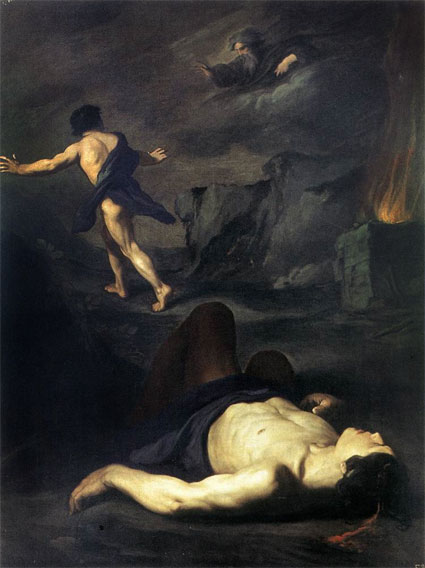
The Rest of the Dead
I saw the souls of those who had been beheaded for their witness to Jesus and for the word of God, who had not worshiped the beast or his image, and had not received [his] mark on their foreheads or on their hands. And they lived and reigned with Christ for a thousand years. But the rest of the dead did not live again until the thousand years were finished. This is the first resurrection. Revelation 20:4-5
James Jordan writes:
Continue reading
Comments Off | tags: Abel, AD70, Cain, James Jordan, Millennium, Resurrection, Revelation, Temple | posted in Against Hyperpreterism, Biblical Theology, The Last Days, Totus Christus
Apr
11
2009
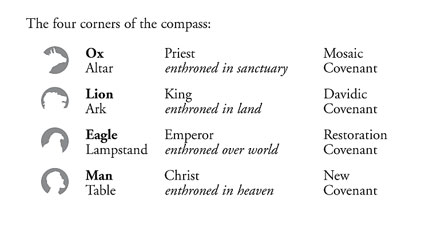
It was always God’s plan that Israel have a human king:
“When you come to the land which the LORD your God is giving you, and possess it and dwell in it, and say, ‘I will set a king over me like all the nations that are around me,’ you shall surely set a king over you whom the LORD your God chooses; one from among your brethren you shall set as king over you; you may not set a foreigner over you, who is not your brother.” Deut. 17:14-15
Like Adam, this dominion would only come by obedience: by servanthood to God and faithful mediatory witness to the Gentiles. But like Adam, they seized dominion and demanded “a king like the Gentiles.” With Saul, they had a king who palled around with Agag of Amalek whom Moses commanded to wipe from the face of the earth.
Continue reading
Comments Off | tags: Abimelech, Amalek, Babylon, Covenant Theology, Daniel, Exile, James Jordan, Malachi, Mordecai, Temple, Zechariah | posted in Biblical Theology, The Restoration Era
Apr
10
2009
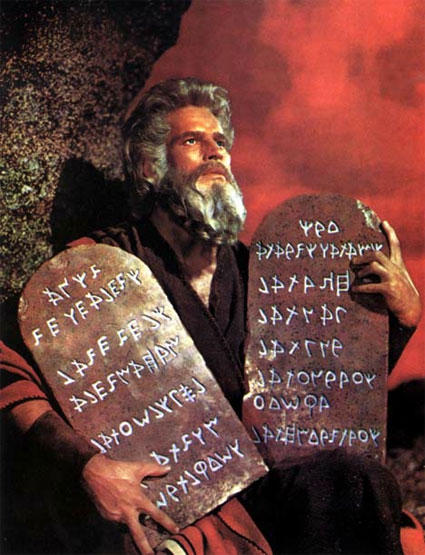
Moses listened on the mountain as God spoke. He digested the law, and repeated it to the next generation in Deuteronomy, partly in a song that he taught them.
Moses’ tabernacle was silent. It was misused and dismembered, then reconstructed in the ‘next generation’ as the Tabernacle of David, with music and Gentile singers.
Continue reading
Comments Off | tags: Culture, Moses, Priesthood, Tabernacle, Temple | posted in Biblical Theology, Ethics
Apr
10
2009
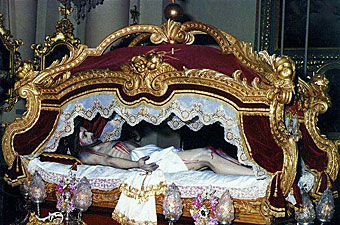
“Catholics do not worship idols, it would be a mortal sin if they did.”
Apparently there is a difference between veneration and worship? That is their argument.
I agree that the common argument against it is a bit weak, but James Jordan writes:
“This commandment is often misinterpreted as stating that no picture of God can be made. This is not what it says. What is says is that no image of anything can be set up as an avenue of worship to God and the court of heaven… Thus, the idea is not that of a “graven” image as opposed to a “molten” image or a “painted” image. The idea is that of a manmade graven object versus the God-made graven Word. The opposition is between God’s content-filled graven Words and man’s silentgraven images. The opposition of God’s verbal covenant and man’s graven images is set out in greater detail in Deuteronomy 4:15-31.”
Continue reading
Comments Off | tags: Church History, James Jordan, Roman Catholicism, Temple, Ten Commandments | posted in Biblical Theology, Ethics, The Restoration Era
Apr
10
2009
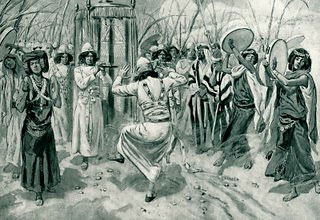 What gave David the right to add music, singing and dancing to the Tabernacle worship? The Tent of Moses was a place of silence.
What gave David the right to add music, singing and dancing to the Tabernacle worship? The Tent of Moses was a place of silence.
The answer is in Deuteronomy. The Law was given to Moses at Sinai (Firstfruits), and repeated to the next generation before Israel crossed the Jordan. In between was 40 years of testing in the wilderness. God spoke at Sinai, and Moses listened in silence. But in Deuteronomy (Trumpets), it was Moses, the mediator, who “sang” the Law (Deut 31-32).
On to King David. After the continued flagrant disobedience of the sons of Eli, the Ark took itself into the ‘wilderness’ on Israel’s behalf at the hand of the Philistines, and conquered the serpent (Dagon). Besides a plunder of Philistine gold, it returned with both Jew and Gentile singers in a restructured worship that included music. The silent Tent of Moses, ready to pass away, had been broken down and prepared for incorporation into a permanent Temple built of David’s spoils. It was a bride ready for Solomon the bridegroom.
In the New Testament, following Christ’s example, the church came out of the Egypt of corrupted Judaism. She was tested in the wilderness, like Israel, with persecution and false teachers. Before the full inauguration of the New Covenant in AD70, she was presented as a bride ready for her husband, a rebuilt Tabernacle of David (Isaiah 16:5; Amos 9:11; Acts 15:16). Paul the tentmaker had completed the difficult process of stitching together a bride from both Jewish and Gentile worshippers. Purified by testing, she was a wise virgin with her lamps full of Pentecost oil. Her music was a new song accompanied by the seven Trumpets that brought the fall of Herod’s Jericho. The marriage feast of the Lamb followed, and Greater Solomon now rules the earth with His bride – a Temple built of living stones – until all enemies are under His feet.
At ascension (Firstfruits), Adam speaks and Eve listens as a people. Testing follows. At Trumpets, Greater Eve is a holy army ready to conquer. Now Eve sings.
Comments Off | tags: David, Feasts, Moses, Tabernacle, Temple | posted in Biblical Theology
Apr
10
2009
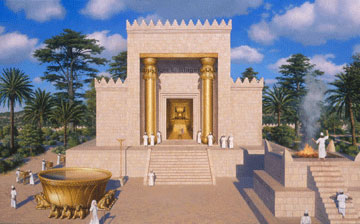
When Solomon’s Temple replaced the Tabernacle, everything was more glorious. Among the enhancements and additions were two great bronze pillars at the entrance. One of the things the Tabernacle symbolises is a great metal man. The glorified Christ is seen in visions with legs of molten bronze, or a fiery, angelic stream that reaches down to the Altar of the earth. The Tabernacle was a portable ‘flying’ chariot of God. These two great pillars, priest and king, were its landing gear.They pictured the union of heaven and earth, and Jew-priest-Land and Gentile-king-Sea in Christ, Greater Solomon.
“I saw still another mighty angel coming down from heaven, clothed with a cloud. And a rainbow was on his head, his face was like the sun, and his feet like pillars of fire. He had a little book open in his hand. And he set his right foot on the sea and his left foot on the land…” (Revelation 10:1-2)
Comments Off | tags: Revelation, Tabernacle, Temple, Typology | posted in Biblical Theology
Apr
10
2009
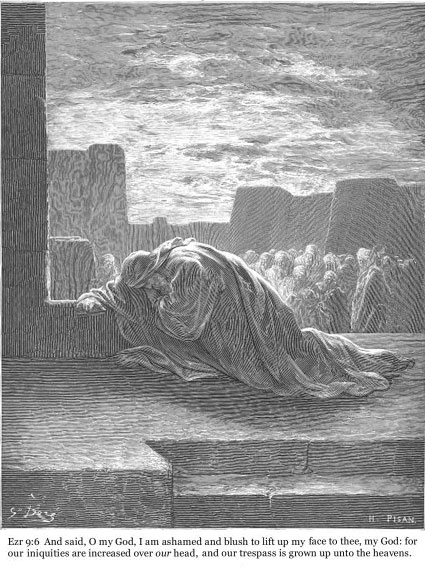
Ezra took a great risk to bring Levites and riches to the Temple from Persia. Mixed marriages were suddenly of more concern, which poses a difficult question. Things seem to be heading backwards—away from the New Testament rather than towards it.
Continue reading
Comments Off | tags: Ezra, Nehemiah, Peter Leithart, Pharisees, Priesthood, Resurrection, Tabernacle, Temple | posted in Biblical Theology, The Restoration Era
Apr
10
2009
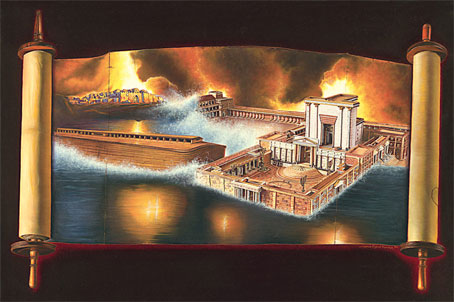
A couple of guys have written a book called Beyond Creation Science. As preterists, they understand there was a symbolic ‘flood’ across the Land of Israel under both Nebuchadnezzar’s Babylon and Nero/Vespasian’s Rome. Problem is, they read this back into Noah’s flood and try to say that this was only a local flood, which then allows them to compromise with old-earth Creationism.
It was ‘long-age’ geological assumptions that provided a ‘foundation’ for Darwin’s long-age biological fantasy. I would recommend Tas Walker’s site, Biblical Geology, for someone who really knows his stuff.
The position of these fellows causes more problems than it fixes. It makes the Bible’s very detailed chronology a joke, and forces a gap of millions of years into Genesis 1.
Here’s the solution:
Adam’s failure brought physical de-Creation. Cain founded a corrupt civilisation whose evil influence triumphed and was destroyed in a literal flood. Just like Cain, Ham was cursed, and his son Canaan’s influence led to social de-Creation. As God raised new land out of the waters after the flood, God would now perform another Creation miracle. In calling Abram, God was socially dividing the waters of the nations into the Land and the Sea. The era of the patriarchs, ruling fathers, began. God called Abram, and tore the world in two.
The land and sea division was a literal, physical land and sea in early Genesis. The ark of Noah was a literal ’world-in-a-box’, a safehouse and doorway to a new world. But when God called Abram, the ‘Land and Sea’ division was purely social, and the Tabernacle and Temple were a symbolic ‘world-in-a-box.’ These guys have confused these two and unwittingly undermined the authority of Scripture.
[Also, on hyperpreterist ‘Covenant Creationism’, see A Chronic Hysteresis.]
Comments Off | tags: Abraham, Against Hyperpreterism, Bible Chronology, Covenant Creationism, Temple, The flood | posted in Against Hyperpreterism, Biblical Theology, Creation, The Last Days
Apr
10
2009
Greater Solomon
The structure of Revelation passes through two large heptamerous cycles (1-11 and 12-19). But the book as a whole follows the same pattern as Ezekiel. In the last three chapters, following Ezekiel’s pattern, John is shown the destruction of Gog (Amalek) in the Land, and a vision of a new Jerusalem. However, unlike Ezekiel, these events are beyond the second cycle of the book, and for good reason. This final “east-west” section exiles the Accuser to the Abyss (Azal) and enthrones the Bride. It is the only part of Revelation that directly concerns our own day.
Continue reading
Comments Off | tags: AD70, Amalek, Ark of the Covenant, Babylon, Millennium, Moses, Postmillennialism, Revelation, Solomon, Temple, Typology, Zechariah | posted in Against Hyperpreterism, Biblical Theology, The Last Days

































